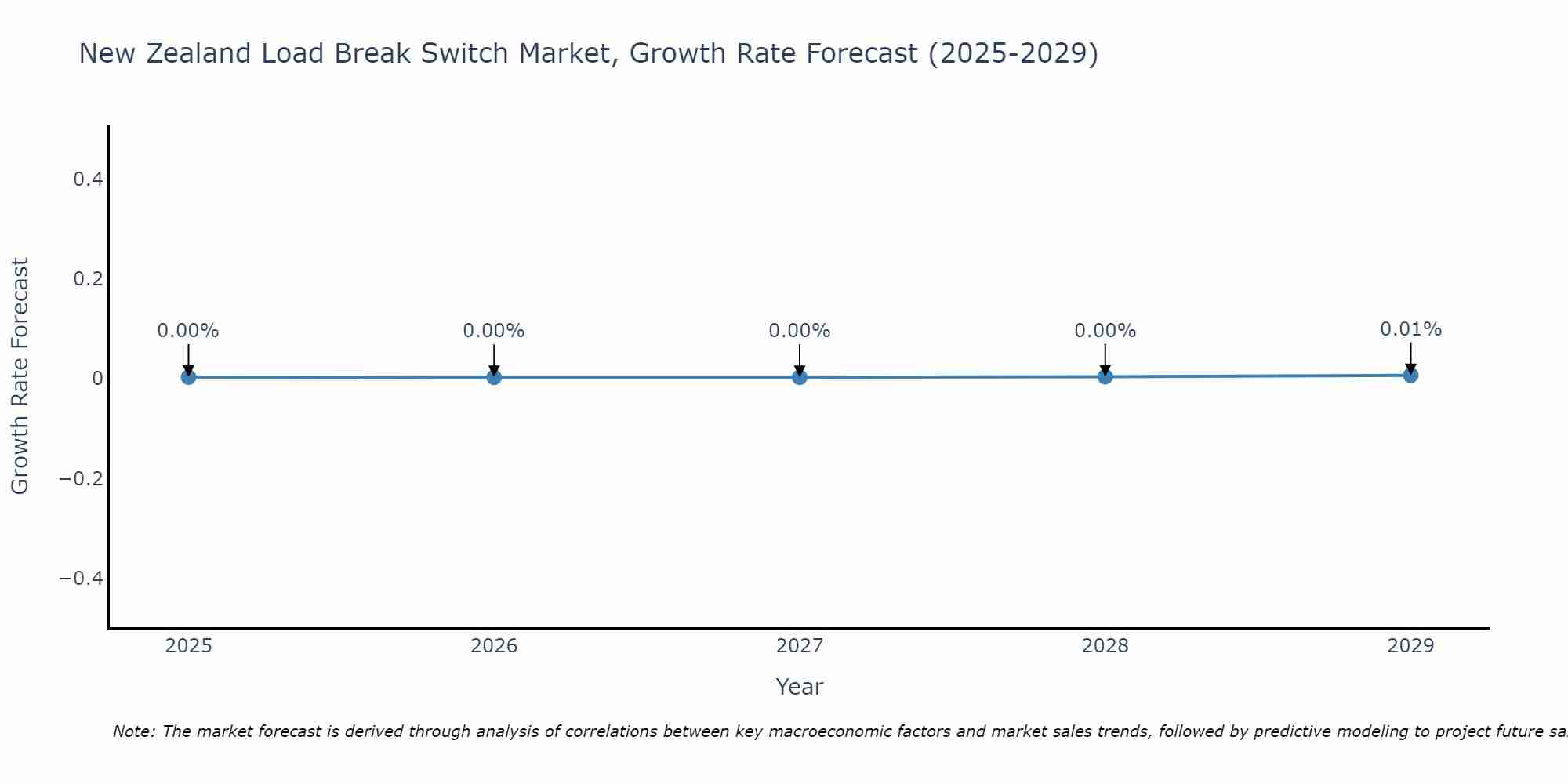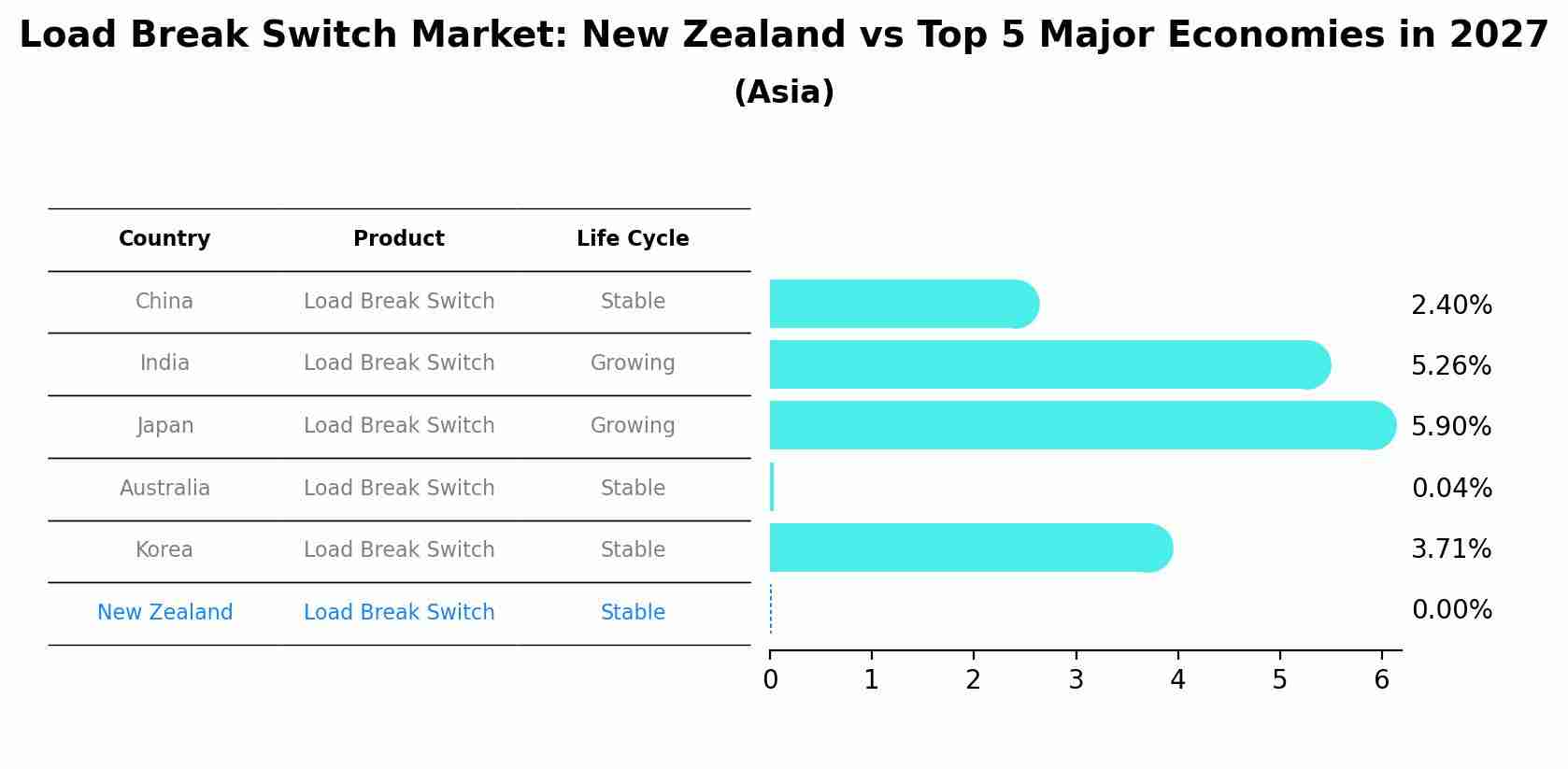New Zealand Load Break Switch Market (2025-2031) | Analysis, Share, Value, Outlook, Companies, Size, Segmentation, Trends, Industry, Forecast, Growth & Revenue
| Product Code: ETC5128292 | Publication Date: Nov 2023 | Updated Date: Sep 2025 | Product Type: Market Research Report | |
| Publisher: 6Wresearch | Author: Bhawna Singh | No. of Pages: 60 | No. of Figures: 30 | No. of Tables: 5 |
New Zealand Load Break Switch Market Size Growth Rate
The New Zealand Load Break Switch Market is projected to witness mixed growth rate patterns during 2025 to 2029. Commencing at 0.00% in 2025, growth builds up to 0.01% by 2029.

Load Break Switch Market: New Zealand vs Top 5 Major Economies in 2027 (Asia)
In the Asia region, the Load Break Switch market in New Zealand is projected to expand at a stable growth rate of 0.00% by 2027. The largest economy is China, followed by India, Japan, Australia and South Korea.

New Zealand Load Break Switch Market Overview
The load break switch market in New Zealand is crucial for the electrical distribution network, ensuring safety and reliability. The market is driven by the demand for robust and efficient electrical infrastructure.
Drivers of the market
The load break switch market in New Zealand is driven by the need for reliable and efficient electrical switching solutions in various industries, including power distribution, utilities, and industrial automation. Load break switches are essential for isolating and protecting electrical circuits, ensuring safe and efficient operation. The growing investment in upgrading and expanding the electrical grid, the push for renewable energy integration, and the increasing demand for smart grid solutions support market growth. Additionally, advancements in switch technology that enhance performance, safety, and ease of use further drive the demand for load break switches.
Challenges of the market
The load break switch market in New Zealand encounters hurdles in terms of technological advancements and product reliability. As utilities strive to modernize their grid infrastructure and improve operational efficiency, demand for robust and versatile load break switches grows. However, ensuring the reliability and resilience of these critical components remains a persistent challenge.
Government Policy of the market
Industrial safety regulations, energy policies, and infrastructure development impact the load break switch market. Government emphasis on electrical safety standards and support for infrastructure upgrades drive market growth. Policies promoting energy efficiency and grid modernization are also crucial.
Key Highlights of the Report:
- New Zealand Load Break Switch Market Outlook
- Market Size of New Zealand Load Break Switch Market, 2024
- Forecast of New Zealand Load Break Switch Market, 2031
- Historical Data and Forecast of New Zealand Load Break Switch Revenues & Volume for the Period 2021-2031
- New Zealand Load Break Switch Market Trend Evolution
- New Zealand Load Break Switch Market Drivers and Challenges
- New Zealand Load Break Switch Price Trends
- New Zealand Load Break Switch Porter`s Five Forces
- New Zealand Load Break Switch Industry Life Cycle
- Historical Data and Forecast of New Zealand Load Break Switch Market Revenues & Volume By Type for the Period 2021-2031
- Historical Data and Forecast of New Zealand Load Break Switch Market Revenues & Volume By Gas-Insulated for the Period 2021-2031
- Historical Data and Forecast of New Zealand Load Break Switch Market Revenues & Volume By Air-Insulated for the Period 2021-2031
- Historical Data and Forecast of New Zealand Load Break Switch Market Revenues & Volume By Others for the Period 2021-2031
- Historical Data and Forecast of New Zealand Load Break Switch Market Revenues & Volume By Deployment for the Period 2021-2031
- Historical Data and Forecast of New Zealand Load Break Switch Market Revenues & Volume By Outdoor for the Period 2021-2031
- Historical Data and Forecast of New Zealand Load Break Switch Market Revenues & Volume By Indoor for the Period 2021-2031
- Historical Data and Forecast of New Zealand Load Break Switch Market Revenues & Volume By End-User for the Period 2021-2031
- Historical Data and Forecast of New Zealand Load Break Switch Market Revenues & Volume By Utilities for the Period 2021-2031
- Historical Data and Forecast of New Zealand Load Break Switch Market Revenues & Volume By Commercial for the Period 2021-2031
- Historical Data and Forecast of New Zealand Load Break Switch Market Revenues & Volume By Industrial for the Period 2021-2031
- New Zealand Load Break Switch Import Export Trade Statistics
- Market Opportunity Assessment By Type
- Market Opportunity Assessment By Deployment
- Market Opportunity Assessment By End-User
- New Zealand Load Break Switch Top Companies Market Share
- New Zealand Load Break Switch Competitive Benchmarking By Technical and Operational Parameters
- New Zealand Load Break Switch Company Profiles
- New Zealand Load Break Switch Key Strategic Recommendations
Frequently Asked Questions About the Market Study (FAQs):
1 Executive Summary |
2 Introduction |
2.1 Key Highlights of the Report |
2.2 Report Description |
2.3 Market Scope & Segmentation |
2.4 Research Methodology |
2.5 Assumptions |
3 New Zealand Load Break Switch Market Overview |
3.1 New Zealand Country Macro Economic Indicators |
3.2 New Zealand Load Break Switch Market Revenues & Volume, 2021 & 2031F |
3.3 New Zealand Load Break Switch Market - Industry Life Cycle |
3.4 New Zealand Load Break Switch Market - Porter's Five Forces |
3.5 New Zealand Load Break Switch Market Revenues & Volume Share, By Type, 2021 & 2031F |
3.6 New Zealand Load Break Switch Market Revenues & Volume Share, By Deployment, 2021 & 2031F |
3.7 New Zealand Load Break Switch Market Revenues & Volume Share, By End-User, 2021 & 2031F |
4 New Zealand Load Break Switch Market Dynamics |
4.1 Impact Analysis |
4.2 Market Drivers |
4.2.1 Increasing demand for electricity and infrastructural development projects in New Zealand |
4.2.2 Growing emphasis on renewable energy sources leading to investments in smart grid projects |
4.2.3 Technological advancements in load break switches enhancing efficiency and reliability |
4.3 Market Restraints |
4.3.1 Fluctuating raw material prices impacting manufacturing costs |
4.3.2 Stringent regulatory standards and compliance requirements |
4.3.3 Competition from alternative technologies such as vacuum circuit breakers |
5 New Zealand Load Break Switch Market Trends |
6 New Zealand Load Break Switch Market Segmentations |
6.1 New Zealand Load Break Switch Market, By Type |
6.1.1 Overview and Analysis |
6.1.2 New Zealand Load Break Switch Market Revenues & Volume, By Gas-Insulated, 2021-2031F |
6.1.3 New Zealand Load Break Switch Market Revenues & Volume, By Air-Insulated, 2021-2031F |
6.1.4 New Zealand Load Break Switch Market Revenues & Volume, By Others, 2021-2031F |
6.2 New Zealand Load Break Switch Market, By Deployment |
6.2.1 Overview and Analysis |
6.2.2 New Zealand Load Break Switch Market Revenues & Volume, By Outdoor, 2021-2031F |
6.2.3 New Zealand Load Break Switch Market Revenues & Volume, By Indoor, 2021-2031F |
6.3 New Zealand Load Break Switch Market, By End-User |
6.3.1 Overview and Analysis |
6.3.2 New Zealand Load Break Switch Market Revenues & Volume, By Utilities, 2021-2031F |
6.3.3 New Zealand Load Break Switch Market Revenues & Volume, By Commercial, 2021-2031F |
6.3.4 New Zealand Load Break Switch Market Revenues & Volume, By Industrial, 2021-2031F |
7 New Zealand Load Break Switch Market Import-Export Trade Statistics |
7.1 New Zealand Load Break Switch Market Export to Major Countries |
7.2 New Zealand Load Break Switch Market Imports from Major Countries |
8 New Zealand Load Break Switch Market Key Performance Indicators |
8.1 Percentage of load break switch installations in smart grid projects |
8.2 Rate of adoption of advanced load break switch technologies in the market |
8.3 Number of infrastructure development projects using load break switches in New Zealand |
9 New Zealand Load Break Switch Market - Opportunity Assessment |
9.1 New Zealand Load Break Switch Market Opportunity Assessment, By Type, 2021 & 2031F |
9.2 New Zealand Load Break Switch Market Opportunity Assessment, By Deployment, 2021 & 2031F |
9.3 New Zealand Load Break Switch Market Opportunity Assessment, By End-User, 2021 & 2031F |
10 New Zealand Load Break Switch Market - Competitive Landscape |
10.1 New Zealand Load Break Switch Market Revenue Share, By Companies, 2024 |
10.2 New Zealand Load Break Switch Market Competitive Benchmarking, By Operating and Technical Parameters |
11 Company Profiles |
12 Recommendations | 13 Disclaimer |
- Single User License$ 1,995
- Department License$ 2,400
- Site License$ 3,120
- Global License$ 3,795
Search
Thought Leadership and Analyst Meet
Our Clients
Related Reports
- Vietnam System Integrator Market (2025-2031) | Size, Companies, Analysis, Industry, Value, Forecast, Growth, Trends, Revenue & Share
- ASEAN and Thailand Brain Health Supplements Market (2025-2031) | Strategy, Consumer Insights, Analysis, Investment Trends, Opportunities, Growth, Size, Share, Industry, Revenue, Segments, Value, Segmentation, Supply, Forecast, Restraints, Outlook, Competition, Drivers, Trends, Demand, Pricing Analysis, Competitive, Strategic Insights, Companies, Challenges
- ASEAN Bearings Market (2025-2031) | Strategy, Consumer Insights, Analysis, Investment Trends, Opportunities, Growth, Size, Share, Industry, Revenue, Segments, Value, Segmentation, Supply, Forecast, Restraints, Outlook, Competition, Drivers, Trends, Demand, Pricing Analysis, Competitive, Strategic Insights, Companies, Challenges
- Europe Flooring Market (2025-2031) | Outlook, Share, Industry, Trends, Forecast, Companies, Revenue, Size, Analysis, Growth & Value
- Saudi Arabia Manlift Market (2025-2031) | Outlook, Size, Growth, Trends, Companies, Industry, Revenue, Value, Share, Forecast & Analysis
- Uganda Excavator, Crane, and Wheel Loaders Market (2025-2031) | Strategy, Consumer Insights, Analysis, Investment Trends, Opportunities, Growth, Size, Share, Industry, Revenue, Segments, Value, Segmentation, Supply, Forecast, Restraints, Outlook, Competition, Drivers, Trends, Demand, Pricing Analysis, Competitive, Strategic Insights, Companies, Challenges
- Rwanda Excavator, Crane, and Wheel Loaders Market (2025-2031) | Strategy, Consumer Insights, Analysis, Investment Trends, Opportunities, Growth, Size, Share, Industry, Revenue, Segments, Value, Segmentation, Supply, Forecast, Restraints, Outlook, Competition, Drivers, Trends, Demand, Pricing Analysis, Competitive, Strategic Insights, Companies, Challenges
- Kenya Excavator, Crane, and Wheel Loaders Market (2025-2031) | Strategy, Consumer Insights, Analysis, Investment Trends, Opportunities, Growth, Size, Share, Industry, Revenue, Segments, Value, Segmentation, Supply, Forecast, Restraints, Outlook, Competition, Drivers, Trends, Demand, Pricing Analysis, Competitive, Strategic Insights, Companies, Challenges
- Angola Excavator, Crane, and Wheel Loaders Market (2025-2031) | Strategy, Consumer Insights, Analysis, Investment Trends, Opportunities, Growth, Size, Share, Industry, Revenue, Segments, Value, Segmentation, Supply, Forecast, Restraints, Outlook, Competition, Drivers, Trends, Demand, Pricing Analysis, Competitive, Strategic Insights, Companies, Challenges
- Israel Intelligent Transport System Market (2025-2031) | Strategy, Consumer Insights, Analysis, Investment Trends, Opportunities, Growth, Size, Share, Industry, Revenue, Segments, Value, Segmentation, Supply, Forecast, Restraints, Outlook, Competition, Drivers, Trends, Demand, Pricing Analysis, Competitive, Strategic Insights, Companies, Challenges
Industry Events and Analyst Meet
Whitepaper
- Middle East & Africa Commercial Security Market Click here to view more.
- Middle East & Africa Fire Safety Systems & Equipment Market Click here to view more.
- GCC Drone Market Click here to view more.
- Middle East Lighting Fixture Market Click here to view more.
- GCC Physical & Perimeter Security Market Click here to view more.
6WResearch In News
- Doha a strategic location for EV manufacturing hub: IPA Qatar
- Demand for luxury TVs surging in the GCC, says Samsung
- Empowering Growth: The Thriving Journey of Bangladesh’s Cable Industry
- Demand for luxury TVs surging in the GCC, says Samsung
- Video call with a traditional healer? Once unthinkable, it’s now common in South Africa
- Intelligent Buildings To Smooth GCC’s Path To Net Zero


















